|

Summer 1998 (6.2)
Walking Tour
Baku's
Old City
by Fuad Akhundov

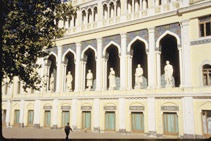  1. Nizami Museum of Literature 1. Nizami Museum of Literature
(See
Literary Monuments, AI 4.1) This museum features historical
samples of written literature. Originally, the building housed
the most luxurious hotel in Baku, known as the Metropol. In 1940,
during the Soviet period, the hotel was converted into a literature
museum. Mikayil Huseinov and Sadigh Dadashev renovated the building
for the commemoration of the 800th anniversary of Azer-baijani
poet Nizami Ganjavi (1141-1204).
The statue in front of the museum,
commemorates the memory of poet Nizami Ganjavi. It was designed
by Fuad Abdurahmanov in 1949.
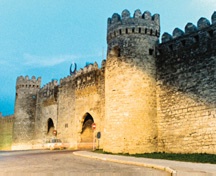  2. Fortress Walls 2. Fortress Walls
From Nizami Square, walk left through the double arches of the
Fortress Wall. The original wall formed a rampart, and was constructed
by King Manoucher II (1120-1159). Since then, it has been reconstructed.
The wall encircles the most ancient part of Baku called "Ichari
Shahar" (Inner City), and preserves the image of a medieval
Oriental citadel. The buildings located outside the fortress
walls were primarily constructed during the Oil Boom-1870 to
1920.
Baku's most ancient Coat of
Arms can be seen above the northwest entrance of the fortress
walls above the Twin Gates (Gosha Gala). Two lions guard a bull
under the symbols of the sun and the moon.
3. Square (Meydan)
4. Carpet gallery
5. Caravansaray(Inns)
The Bukhara Caravanserai (right) with its medieval courtyard
served as a medieval inn and tavern in the 15th century while
the Multani Caravanserai (left) dates to the 14th century. Both
inns were presumably built and used by merchants traveling by
camel caravan from Bukhara (present-day Uzbekistan) and Multan
(India). Both have since been converted into restaurants which
serve traditional Azerbaijani cuisine.
6. Market Square and
Haji-Bani Bathhouse
This area were excavated in mid-1960s and found to date back
to the 16-17th century.
7. Maiden's Tower (See
Maiden's Tower, 4.2).
Baku's landmark symbol is believed to date to 12th century. The
name of the Tower-Maiden's-is explained by numerous legends concerning
a determined young lady pursued by a despotic local king (sometimes
identified as her father), who reportedly imprisoned her in this
Tower. According to the legend, rather than becoming his lover,
she committed suicide by throwing herself from the Tower into
the Caspian Sea
8. Hajinski Residence
In front of the Maiden's Tower towards the sea is the palatial
residence of Issa-bey Hajinski (1862-1918) who was a famous oil
baron, nobleman and public figure during the Oil Boom. The building
was constructed in approximately 1912. In November 1944, Charles
de Gaulle stayed there as guest while traveling through Baku
on his way between Paris and Moscow.
9. Madraseh and Mosque
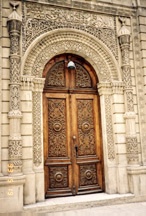  10. Friday Mosque 10. Friday Mosque
The minaret on this mosque that has been reconstructed dates
to 1441. The original mosque was constructed by Shirvan-shah
Khalil I. In the 1900s, the mosque was completely renovated by
Haji Shikhali Dadashev, a rich merchant and ship owner. The Madraseh
(religious school) and Mosque date to 1301.
11. Mustafazade Home
Museum
(See Vagif
Mustafazade 5.4, See Aziza
Mustafa Zadeh, 4.4)
Vagif Mustafazade (1940-1979)
was founder of Azerbaijani jazz-mugam. Climb the narrow stairs
to the third floor to see what was originally a one-room unpretentious
apartment where he grew up with his mother, a music teacher (See
AI 5.4, Winter 1997). The statue relief on the building at the
corner was sculpted by Omar Eldarov, who is currently a Member
of Parliament.
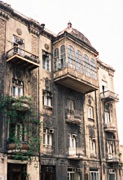
12. Ramazanov Residence (right)
This beautiful mansion was built in the 1890s.
13. Gasim-bey Bath
House
This public bath house dates back to the 17th century. Residents
of the Inner City are fond of joking that the owner himself had
as many wives as there are domes on the bath house! Today, it
houses a Museum of Herbal Pharmacy.
Exit out of the fortress through
the south (Salyan Gates) into what used to be known as the Governor's
Garden. Originally, these grounds were cultivated by R. R Khoven,
Baku Commandant (mid-1830s to 1890s). Today, it is called the
park of Ali Agha Vahid, one of Azerbaijan's famous 19th century
poets.
14. SOCAR Building
The present day office building of SOCAR (State Oil Company of
the Azerbaijan Republic) was previously the former mansion of
Mir-Taghy Mir-Babayev, a talented Azerbaijani folk singer, who
was given a piece of land as payment for his performance at a
wedding. He struck oil on the property and, subsequently, became
an oil baron. The palace was designed by P. Stern in 1893 and
construction was completed in 1896 [See "Legacy of the Oil
Barons," AI 3.1, Spring 1995].
15. Statue to Vahid
Continue walking up the hill on Niyazi Street. [By the way, Niyazi
(1912-1984) was Azerbaijan's most famous symphonic conductor,
see AI 5.4, Winter 1997]. To your right , look for a uniquely
carved monument of a very large head. It honors the poet Vahid
(1896-1965). Scenes from numerous of his works are depicted on
his neck and hair. The monument was sculpted by Rahib Hasanov
and Arif Mansurov and unveiled in 1990.
16. National Museum
of Fine Arts
Opposite the sculpture on the other side of Niyazi Street is
the National Museum of Fine Arts. The building was the former
palatial residence of Claude de Burr and designed by Nicholas
A. von der Nonne in 1888 and constructed around 1891.
17. Adjunct - Art Museum
The building next to the Art Museum further up the hill on Niyazi
Street serves as an adjunct to the museum. Originally, it was
constructed as the Girl's School of St. Mary's in 1885. In the
courtyard in the back of the building, there are three bronze
busts which originally used to stand in Shusha, an Azerbaijani
city in Nagorno-Karabakh now under military occupation by Armenians.
The bullet-ridden sculptures honor composer Uzeyir Hajibeyov
(1885-1948), singer Bul-bul (1887-1961) and poetess Natavan (1830-1897).
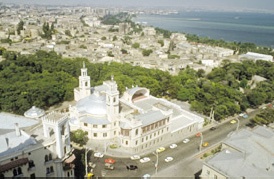  18. Philharmonic Hall 18. Philharmonic Hall
Presently, the Philharmonic
Hall is undergoing reconstruction as it was in a desperate state
of disrepair. Originally constructed as a former public assembly
in 1910-1912, the architectural design was based on a famous
casino in Monte Carlo. During the Soviet period, the building
was converted into a music hall for which it continues to be
used today. The Philharmonic has an outdoor concert shell on
the south side towards the sea.
19. President's
Office (below)
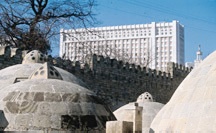  20. Baksoviet Metro Station 20. Baksoviet Metro Station
Take a right on Istiglal (Independence) Street. Continue walking
past Vahid Park. On the right is the Baksoviet Metro Station,
which was the first underground station ever constructed in Baku
(completed in March 1967).
21. City Hall
The
Baksoviet Bulding (City Hall and Mayor's Office) was designed
and constructed in 1900-1904 by the Polish architect, Joseph
V Goslavsky (1865-1904). He died at age 39 of tuberculosis immediately
upon completion of the building.
22. Palace of Shirvan
Shahs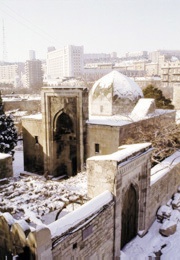 (right)
(right)
After passing City Hall, go back inside the Fortress walls, to
the  extraordinary architecture of the 15th
century, known as the Royal Palace of Shirvan-Shahs-Kings of
Shirvan. The complex has four levels and six integral parts.
It was constructed in 1435-1442 by King Khalil and his son Farrokh
Yassar. In 1964, the Palace was assigned the status of a national
museum. It is currently under renovation. Tours are available. extraordinary architecture of the 15th
century, known as the Royal Palace of Shirvan-Shahs-Kings of
Shirvan. The complex has four levels and six integral parts.
It was constructed in 1435-1442 by King Khalil and his son Farrokh
Yassar. In 1964, the Palace was assigned the status of a national
museum. It is currently under renovation. Tours are available.
23. Economic Institute
of Azerbaijan
Back out on Istiglal Street, on the same side as the City Hall,
is the national Economic Institute of Azerbaijan. Formerly it
was the Baku Modern School (the largest secondary school for
boys), designed by D. D. Buynov and constructed between 1901-1904.
24. Wedding Palace (See
Wedding Palace, AI 2.4)
At the Economic Institute, as an alternative variant of your
tour, you may cross over to the other side of Istiglal street
and take Mukhtarov Street. On the right hand side of the street,
the entire length of the block is what used to be an extraordinary
residence styled after a French Gothic Palace. It was built by
Oil Baron Murtuza Mukhtarov in 1911-1912, and designed by architect
J. K. Ploshdo and constructed by the Kasumov Brothers' Company.
Mukhtarov came to an untimely
death when Bolsheviks rode horseback up the grand stairway in
this palace. He had declared that not a single Bolshevik would
ever step foot in his palace. When they did, he took out his
pistol and shot at them and then turned the pistol on himself.
(See "Legacy of the Oil Barons," AI 2.4, Autumn 1994).
Mukhtarov was among the most famous oil barons. The mansion was
built for his wife, Liza, who had marveled at this building while
touring Italy. During the Soviet period, the residence was converted
into a Wedding Palace where civil wedding ceremonies took place.
Today, the building still serves the same purpose. You can often
catch a glimpse of a bridal couple and their wedding parties
there. The building also houses the administrative offices of
the Composer's Union.
25. Institute of Manuscripts (See
Medical Manuscripts, AI 5.3)
Back on Istiglal's street on the same side of the street as the
Economics Institute is another museum which houses the Institute
of Manuscripts. Designed by Joseph V. Goslavsky and constructed
between 1896-1901, the building was constructed by Oil Baron
Taghiyev, who was known as Baku's greatest philanthropist. It
became the First Girl's School, in other words, the first secular
school for Moslem girls in the entire Oriental world. This boarding
school functioned between October 1901 until March 1918.
On December 18, 1918, the Parliament
of the first Democratic Republic of Azerbaijan convened in this
building, again, marking another first-the first European Parliament
in the Moslem world).
These days, the building houses
the Institute of the Manuscripts' Archives of Azerbaijan. Many
original works are on display, including great literary and medical
manuscripts. Most documents are written in Arabic script (the
alphabet used in Azerbaijan until 1938).
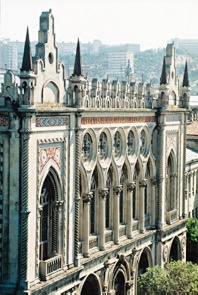  26. Ismayil's Palace 26. Ismayil's Palace
(See
Naghiyev, AI 2.2)
Baku's most ornate palatial residence-the Ismayiliye Palace-was
built by oil baron Agha Musa Naghiyev (1849-1919), who was known
as both the richest oil baron in Baku as well as the stingiest
one. This beautiful edifice in Venetian Gothic style was designed
by J. K. Ploshko between 1907-1913. Naghiyev gifted it to the
Benevolent Societies of Azerbaijan in memory of his son who had
died of tuberculosis at an early age. For this reason, it takes
its name after Naghiyev's son, Ismayil. The architecture of the
palace is strikingly reminiscent of Palazzo Contarini in Venice.
In March 1918, the Ismayiliye
Palace was looted and burned by Armenians and communists in their
attempt to take over the city. After the Soviet occupation of
the Baku, the Soviets rebuilt the palace. The Soviet symbols
(five stars) can be seen on the facade of the building. These
days, the building houses the Presidium (administrative offices)
of the Academy of Sciences
27. Statue to Sabir (right)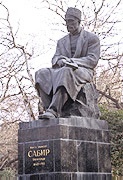
Monument to the poet and writer of satire Mirza Alakbar Sabir
 (1862-1911). The statue is by J. Garyagry. (1862-1911). The statue is by J. Garyagry.
28. The Monolith
The gigantic apartment complex (opposite Sabir's monument on
Istiglal Avenue) was designed by K. Senchilhin during Stalin's
era in the early 1940s. The name "Monolith," meaning
"single stone" in Greek was given to the structure
due because of its very sturdy and impressive architecture.
Note that the most prominent
avenue in the city which since 1991 has been called "Istiglal"
(Independence) has been changed three times this century. At
first, it was called "Nikolayevskaya" (Nicholas Street)
after the Russian Czar Nicholas I of the Russian Empire. During
the Soviet period, it was called "Kommunistichesjkaya"
(Communist Street). Nevertheless, despite its frequent name change,
the avenue has managed to preserve the original charm of yesteryear
and survived many turbulent political events.
From Azerbaijan International (6.2) Summer 1998.
© Azerbaijan International 1998. All rights reserved.
Back to Index
AI 6.2
(Summer 1998)
AI
Home |
Magazine
Choice
| Topics
| Store
| Contact
us
|








 (right)
(right)
